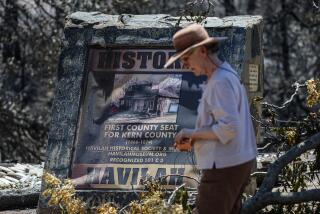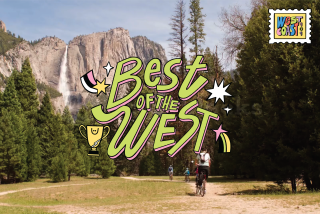Drought brings California gold prospectors back to life

<p>Across California, a crippling drought has reduced the flow in rivers and creeks to the point that a new wave of prospectors is gaining access to places that havenât been reached in decades.</p>
reporting from KERN RIVER CANYON, Calif. â David Fiori, waist-deep in the chilly Kern River, braced against the current, stabbed a shovel into the ancient silt between his feet and tossed the muck downstream. His eyes, though, wandered to a potential prize â a spot on the opposite bank of the river.
To the uninitiated, it looked like just another leafy bend in the 165-mile-long Kern, which carries the snowmelt of the Sierra Nevada toward the sea. But prospectors have had a different sort of perspective in this stretch of California for a long time.
On the other side of the river, Fiori noted, the crystalline water roiled and turned white because it splashed over a cluster of underwater boulders. Itâs the sort of geological quirk that abruptly slows the current, causing heavier elements to settle into the muck of the riverbed â namely, gold.
The spot couldnât be accessed. Not on this day â too deep, too much current â but soon, in a state that seems to be withering like a raisin. Across California, the drought has reduced the flow of rivers and creeks to the point that a new wave of gold prospectors is gaining access to spots that havenât been reached in decades.
The prospectors are well aware of the pain the drought has brought their state. No one is happy about that, but they are gleeful and unrepentant about their new quest, to find a silver lining in flecks of gold.
âThatâs where Iâm going next, as soon as I can,â Fiori said, nodding toward the whitewater on the other side of the river. âAnother couple months, this thing will be down to a trickle. Itâs going to be amazing.â
California is in the third year of severe drought, and 2013 was the driest on record â the driest since the 1500s, according to one study. Gov. Jerry Brown declared a state of emergency earlier this year. Relief will not come soon; the summer will be hot, officials predict, and most of the stateâs primary reservoirs are already far below historical averages.
The stateâs snowpack â the sort that creates the Kern River, dripping from the Mount Whitney area and flowing through the San Joaquin Valley, past Bakersfield â typically provides about a third of the water used on farms and by cities. But the snowpack is at 18% of its average.
Researchers said last week that the drought has meant a loss of $1.7 billion. The toll becomes clearer each day, as water vanishes, and long-submerged highways are revealed; as farmland sits fallow and thousands of jobs are erased; as salmon eggs are left exposed to the air and the harsh sun, killing them; as sheep ranchers cull their herds early because they canât make hay to feed them.
But for one small, proud, iconoclastic community â gold prospectors â the drought has been a boon.
Decent prospectors are famously secretive about their activities, declining to reveal either their precious spots or their take, for fear that others will splash in behind them.
But the signs are everywhere, and in many places where prospectors feel a deep connection to Californiaâs rich history â in Lytle Creek near San Bernardino, named for a Mormon settler in the 1850s; in the San Gabriel River, named after a mission founded by Junipero Serra in 1771; in the Bear River of the Sierra Nevada, where prospectors first arrived during the fabled Gold Rush of 1849.
With gold prices falling lately but still impressive at more than $1,250 an ounce, mining supply stores, in Sacramento, Auburn, Bakersfield, have seen a surge in sales. âSluicingâ classes are being held knee-deep in Cajon Creek, northeast of Los Angeles. The bug is even spreading to dry areas that havenât been underwater for many years â to washes of San Bernardino and Riverside counties, where desert prospectors have dusted off their metal detectors.
This is not a new gold rush; it pales in comparison to the real thing in the mid-1800s, when prospectors sometimes just bent down and plucked nuggets of gold off the dirt. Particularly with legal limits on the use of mechanized machines that vacuum up large amounts of sediment, itâs not a moneymaking scheme for the vast majority of prospectors.
Itâs more than a hobby and less than a rush â more like a fever.
âItâs not the normal, thatâs for sure,â said Farris Farnsworth, a 66-year-old, retired fix-it man, as he swirled a handful of river sand and water in a mining pan on a recent weekend morning. âIf somebody was to walk up and see us down here, theyâd probably think we were a little nuts.â
He stood in a remote access point to the Kern River northeast of Bakersfield, shrouded under a canopy of California bay trees, dappled by sunshine.
Most days, you wouldnât find a soul around here. But on this morning, nine people stood shoulder to shoulder in the middle of the river, all prospecting for gold. The shore was littered with buckets, mining pans and shovels.
âNot all that long ago, this would have been underwater,â said Jeanne Nelle, 56, as she took a break on the riverbank in a lawn chair.
The opening to the river was matted with footprints and reduced to a mud bath; prospectors climbed back to land by grabbing onto overhead branches, sometimes holding their backs after several hours of stooping over the river.
âItâs not for everybody,â Farnsworth said. âIf it was easy, everybody would be doing it. People think prospectors are greedy. Itâs hard work.â
Itâs more a labor of love, really â a throwback pursuit with the pace of another age, a pace that canât be rushed.
On this morning, most of the prospectors had positioned sluices, large metal trays designed to filter soil, in the rolling water of the Kern.
Shoveling muck from the bottom of the river through the sluices gave the prospectors the material they were really after â âblack sand,â the sort closer to the bedrock. Gold is heavy, eight times heavier than the quartz it often originates from, 19 times heavier than water. So when it falls, it tends to settle into the deeper reaches of the soil.
âIt wants to go to the bottom,â said Adolph Lostaunau, 46, an equipment mechanic and the president of the Golden Valley Prospectors Assn. âThe gold just sits there and waits for somebody to get it â like me.â
Black sand was then taken in buckets to the banks of the river, where it was sifted, handful by handful, in timeless mining pans, swirled with water and angled against the sun until a prospector could âsee colorâ â tiny flakes of gold.
Thatâs easy enough; most of these prospectors see color virtually every time out. But nuggets are almost never found. Typically, the luckiest of the group score a âpicker,â a flake heavy enough to make a tiny ping when it lands in a mining pan, even if you have to listen very closely.
Those who do find full-fledged nuggets speak of them in almost mystical terms.
âI found one that big,â said Jay OâDell, holding up a small but verifiable pebble for comparisonâs sake. OâDell, 67, a retiree from Woodlake, near Fresno, has been prospecting for 40 years and has watched the recent surge in interest with bemusement. OâDell found his nugget in Jamestown, near Sonora. He made a pendant out of it. Heâs never worn it.
âIâm afraid Iâll lose it,â he said.
This was a collection of prospectors from two local mining clubs; Farnsworth said not a single one of them has ever sold any gold. But the romance and the link to Californiaâs storied, gleaming past is right below the surface of the water. Farnsworth delicately splashed a bit of water across a pile of black sand in his pan, and then showed it gleaming in the sun.
âThere it is,â he said. âFine California gold. This river, thereâs a little bit of gold in every pan.â
The gold in his pan wouldnât fetch enough money to pay for his gas to travel here from his home in Porterville. But you never know â thatâs a notion that has been drawing prospectors to these rivers for a long time.
âGrab a pan, man, and jump in,â Farnsworth called over his shoulder as he headed back into the river. âYou never know â you might get you a big old nugget.â
More to Read
Sign up for Essential California
The most important California stories and recommendations in your inbox every morning.
You may occasionally receive promotional content from the Los Angeles Times.











